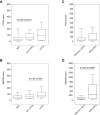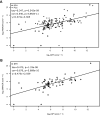Identification of Clinically Significant Prostate Cancer by Combined PCA3 and AMACR mRNA Detection in Urine Samples
- PMID: 32984088
- PMCID: PMC7505712
- DOI: 10.2147/RRU.S262310
Identification of Clinically Significant Prostate Cancer by Combined PCA3 and AMACR mRNA Detection in Urine Samples
Abstract
Purpose: Preclinical evaluation of PCA3 and AMACR transcript simultaneous detection in urine to diagnose clinical significant prostate cancer (prostate cancer with Gleason score ≥7) in a Russian cohort.
Patients and methods: We analyzed urine samples of patients with a total serum PSA ≥2 ng/mL: 31 men with prostate cancer scheduled for radical prostatectomy, 128 men scheduled for first diagnostic biopsy (prebiopsy cohort). PCA3, AMACR, PSA and GPI transcripts were detected by multiplex reverse transcription quantitative polymerase chain reaction, and the results were used for scores for calculation and statistical analysis.
Results: There was no significant difference between clinically significant and nonsignificant prostate cancer PCA3 scores. However, there was a significant difference in the AMACR score (patients scheduled for radical prostatectomy p=0.0088, prebiopsy cohort p=0.029). We estimated AUCs, optimal cutoffs, sensitivities and specificities for PCa and csPCa detection in the prebiopsy cohort by tPSA, PCA3 score, PCPT Risk Calculator and classification models based on tPSA, PCA3 score and AMACR score. In the clinically significant prostate cancer ROC analysis, the PCA3 score AUC was 0.632 (95%CI: 0.511-0.752), the AMACR score AUC was 0.711 (95%CI: 0.617-0.806) and AUC of classification model based on the PCA3 score, the AMACR score and total PSA was 0.72 (95%CI: 0.58-0.83). In addition, the correlation of the AMACR score with the ratio of total RNA and RNA of prostate cells in urine was shown (tau=0.347, p=6.542e-09). Significant amounts of nonprostate RNA in urine may be a limitation for the AMACR score use.
Conclusion: The AMACR score is a good predictor of clinically significant prostate cancer. Significant amounts of nonprostate RNA in urine may be a limitation for the AMACR score use. Evaluation of the AMACR score and classification models based on it for clinically significant prostate cancer detection with larger samples and a follow-up analysis is promising.
Keywords: RNA; alpha-methylacyl-CoA racemase; early diagnosis; neoplasm grading; prostatic neoplasms.
© 2020 Kotova et al.
Conflict of interest statement
Elena S Kotova reports grants from Ministry of Education and Science of Russian Federation, grants from Russian Foundation for Basic Research, grants from Russian Foundation for Basic Research, during the conduct of the study. Yulia A Savochkina is an employee of Lytech Ltd. Alexander O Vasilyev reports grants from Russian Foundation for Basic Research according, during the conduct of the study. Elena A Prilepskay reports grants from Russian Foundation for Basic Research, during the conduct of the study. Konstantin A Babalyan reports grants from Ministry of Education and Science of Russian Federation, during the conduct of the study. Alexander Govorov reports grants from Russian Foundation for Basic Research, during the conduct of the study. Elena S Kostryukova reports grants from Ministry of Education and Science of Russian Federation, during the conduct of the study. Elena I Sharova reports grants from Ministry of Education and Science of Russian Federation, grants from Russian Foundation for Basic Research, during the conduct of the study. The authors reports no other potential conflicts of interest in this work.
Figures



Similar articles
-
A duplex quantitative polymerase chain reaction assay based on quantification of alpha-methylacyl-CoA racemase transcripts and prostate cancer antigen 3 in urine sediments improved diagnostic accuracy for prostate cancer.J Urol. 2009 Jun;181(6):2508-13; discussion 2513-4. doi: 10.1016/j.juro.2009.01.110. Epub 2009 Apr 16. J Urol. 2009. PMID: 19371911 Free PMC article.
-
Prostate Cancer Diagnosis Using Urine Sediment Analysis-Based α-Methylacyl-CoA Racemase Score: A Single-Center Experience.Cancer Control. 2019 Jan-Dec;26(1):1073274819887697. doi: 10.1177/1073274819887697. Cancer Control. 2019. PMID: 31793344 Free PMC article.
-
Urine TMPRSS2:ERG Plus PCA3 for Individualized Prostate Cancer Risk Assessment.Eur Urol. 2016 Jul;70(1):45-53. doi: 10.1016/j.eururo.2015.04.039. Epub 2015 May 16. Eur Urol. 2016. PMID: 25985884 Free PMC article.
-
Urinary Prostate Cancer Antigen 3 as a Tumour Marker: Biochemical and Clinical Aspects.Adv Exp Med Biol. 2015;867:277-89. doi: 10.1007/978-94-017-7215-0_17. Adv Exp Med Biol. 2015. PMID: 26530372 Review.
-
Immunochemical Assays and Nucleic-Acid Detection Techniques for Clinical Diagnosis of Prostate Cancer.J Cancer. 2016 Feb 10;7(5):523-31. doi: 10.7150/jca.13821. eCollection 2016. J Cancer. 2016. PMID: 26958088 Free PMC article. Review.
Cited by
-
Molecular Biomarkers for the Detection of Clinically Significant Prostate Cancer: A Systematic Review and Meta-analysis.Eur Urol Open Sci. 2022 Nov 10;46:105-127. doi: 10.1016/j.euros.2022.10.017. eCollection 2022 Dec. Eur Urol Open Sci. 2022. PMID: 36388432 Free PMC article. Review.
-
A nomogram with coagulation markers for prostate cancer prediction in patients with PSA levels of 4-20 ng/mL.Future Oncol. 2025 Feb;21(4):463-471. doi: 10.1080/14796694.2024.2445499. Epub 2024 Dec 23. Future Oncol. 2025. PMID: 39711215
-
Urine Exosomal AMACR Is a Novel Biomarker for Prostate Cancer Detection at Initial Biopsy.Front Oncol. 2022 Jun 20;12:904315. doi: 10.3389/fonc.2022.904315. eCollection 2022. Front Oncol. 2022. PMID: 35795046 Free PMC article.
-
Deep learning assisted identification of SCUBE2 and SLC16 A5 combination in RNA-sequencing data as a novel specific potential diagnostic biomarker in prostate cancer.Med Biol Eng Comput. 2025 May 8. doi: 10.1007/s11517-025-03365-3. Online ahead of print. Med Biol Eng Comput. 2025. PMID: 40335872
-
Selective Microfluidic Capture and Detection of Prostate Cancer Cells from Urine without Digital Rectal Examination.Cancers (Basel). 2021 Nov 4;13(21):5544. doi: 10.3390/cancers13215544. Cancers (Basel). 2021. PMID: 34771706 Free PMC article.
References
LinkOut - more resources
Full Text Sources
Research Materials
Miscellaneous

